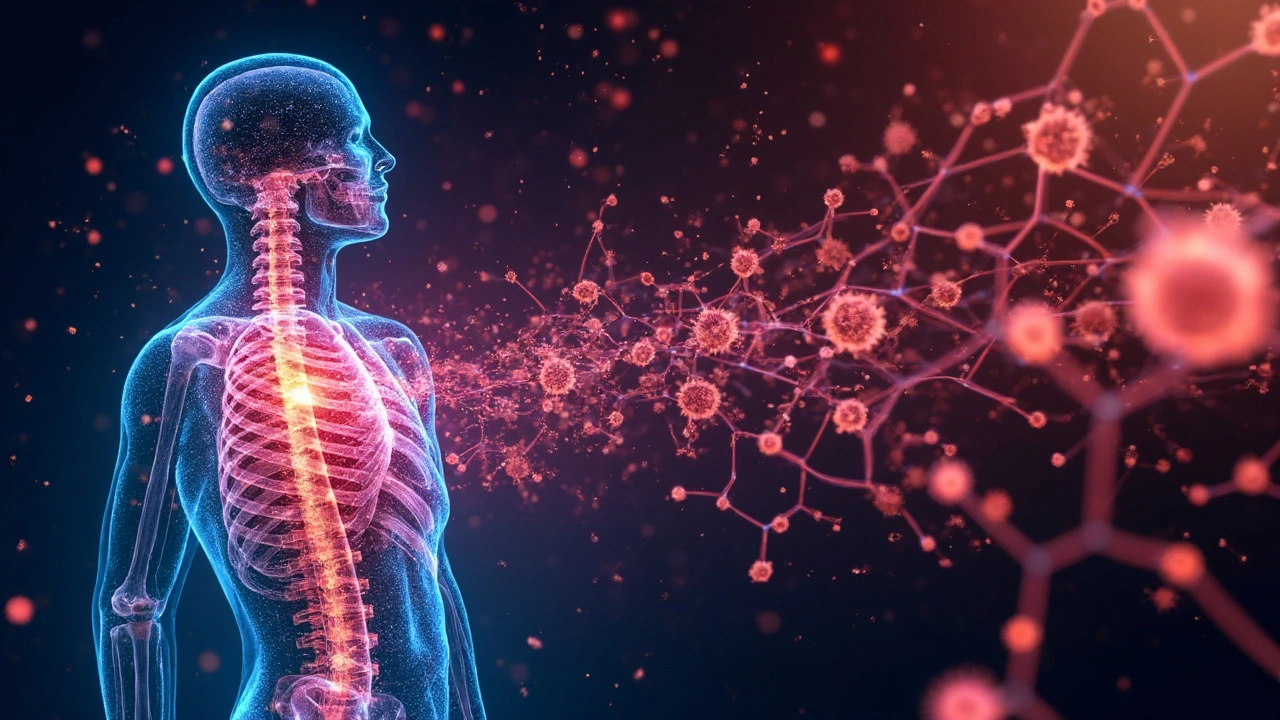Breaking Down Medroxyprogesterone: What Is It?
So, what’s the deal with medroxyprogesterone? It’s a type of hormone therapy, known for doing its magic in treating various conditions. Whether battling some pesky endometriosis or the unpredictability of menstrual disorders, this synthetic form of progesterone often finds itself in the spotlight. But there’s a catch, and it's significant. Here's where bone density steps into the limelight. Our bones, while appearing solid and unchanging, are bustling centers of activity. Every day, cells called osteoclasts and osteoblasts are hard at work breaking down and building up bone. And hormones? They're like the bosses, giving orders and ensuring everything works smoothly. The plot thickens with medroxyprogesterone because it doesn’t quite follow the usual script. Instead of supporting the usual bone health dance, it might make the bones lose density at a faster pace. But why? What’s really happening beneath the surface?
The Science and Studies: Are Bones at Risk?
Diving into the science behind it all—are bones buckling under the strain? Several studies have rolled out their findings over the years, and they don’t mince words. One long-term observation pointed out that women using medroxyprogesterone as a contraceptive saw a noticeable dip in bone mineral density. Yikes! Is it a horror story in the making, though? Not quite. Breaking it down, researchers noted a recovery phase once the medication is stopped, which is a bit of a relief. But it’s still a significant concern for extended use or during those bone-forming teen years when every bit of density counts. So, here's a question worth pondering: Is it crucial enough to change your path? While the exact degree of impact might differ among individuals, being informed never hurts and helps with making smart health choices.

Maintaining Bone Health: Tips and Tricks
Let’s say you need or chose medroxyprogesterone, no worries—you can still look after those bones. Think of it like giving your skeleton a little extra love. First up, good old calcium. You’ve probably heard it a million times, but it truly is a bone’s best friend. Whether through food or supplements, getting enough calcium is non-negotiable. Next, don't forget about vitamin D, because calcium needs a buddy to help with absorption. Spend a little time sun-kissed or supplement when sunlight’s not an option. And don’t underestimate weight-bearing exercises. Walking, jogging, even dancing—they’re all about making those bones stronger. Remember, consistency is key. A regular workout schedule could help counterbalance any potential dips in density you'd rather avoid.
Weighing the Pros and Cons: Informed Decisions
Wrapping it up, let’s talk about the bottom line: informed decisions. Life’s a series of choices, right? Understanding the trade-offs when using medroxyprogesterone is no different. Sure, it's effective for treating certain conditions, but long-term users should be aware of the bone density aspect. However, the decision doesn’t rest solely on this. Each person’s medical needs and how they prioritize them can look very different. Consulting healthcare providers, asking the hard questions, reading up on studies—it all matters. This way, you stand on the side of choice, knowing the potential impact of this medication. After all, knowing what you're getting into is half the battle.

Jen R
March 28, 2025 AT 14:51Alright, so medroxyprogesterone isn’t exactly a bone‑building miracle, but it’s not the apocalypse either. It does nudge osteoclast activity a bit, which can shave off a few percentage points of density over time. If you’re on it for a short stint, your body usually bounces back once you stop. For the long‑term users, especially teens, it’s worth keeping an eye on calcium intake.
Joseph Kloss
March 29, 2025 AT 01:58One could argue that the very notion of “bone health” is a social construct imposed by a patriarchal medical industry. Yet, the empirical data does not lie: increased resorption markers have been observed in controlled trials. The philosophical implication is that we trade skeletal robustness for hormonal convenience. In the grand scheme, is that a fair exchange? Perhaps not, but the choice remains personal.
Anna Cappelletti
March 29, 2025 AT 13:04Hey folks, just wanted to add a hopeful spin. Even if medroxyprogesterone tilts the balance toward loss, the body is remarkably adaptable. Pairing the medication with a solid routine of weight‑bearing exercise and vitamin D can offset most of the dip. Think of it as a teamwork scenario: the drug handles the hormonal side while you handle the mechanical side. Stay consistent and you’ll likely keep your bones sturdy.
Dylan Mitchell
March 30, 2025 AT 00:11OMG, this stuff is like a drama queen of hormones!! It pretends to be all helpful but then whispers to your osteoclasts “let's break stuff”. u cant just ignore it lol. grab your calcium and dance like nobody's watching – that might just save ur bones!!!
Elle Trent
March 30, 2025 AT 11:18From a pharmacokinetic standpoint, medroxyprogesterone acetate exhibits a prolonged half‑life, resulting in sustained receptor occupancy. This pharmacodynamic profile correlates with a measurable attenuation of osteoblastic activity, as evidenced by reduced ALP levels in longitudinal cohorts. Consequently, clinicians should stratify patients by baseline bone mineral density and consider adjunctive bisphosphonate therapy in high‑risk populations. The risk‑benefit calculus must incorporate these metrics to avoid iatrogenic osteopenia.
Jessica Gentle
March 30, 2025 AT 22:24Let’s break this down step by step so everyone can follow along. First, medroxyprogesterone is a synthetic progestin that binds to progesterone receptors throughout the body, including bone tissue. Second, when it binds, it can influence the RANKL/OPG pathway, which is a key regulator of osteoclast differentiation. Third, several studies have shown a modest increase in serum C‑telopeptide, a marker of bone resorption, during continuous use. Fourth, the magnitude of this increase is generally dose‑dependent, meaning higher doses tend to produce larger effects. Fifth, the good news is that after discontinuation, many patients experience a rebound in bone formation markers such as osteocalcin. Sixth, this rebound is thought to be driven by a temporary reduction in circulating progestin, allowing endogenous estrogen to resume its protective role. Seventh, calcium intake of at least 1,200 mg per day is recommended for anyone on long‑term hormonal therapy. Eighth, vitamin D status should be optimized; 800–1,000 IU daily is a common target, though some individuals may require more. Ninth, weight‑bearing exercise – think jogging, stair climbing, resistance training – stimulates osteoblast activity and can counterbalance the resorption signal. Tenth, adequate protein intake (0.8–1 g/kg body weight) supports the collagen matrix of bone. Eleventh, for postmenopausal women or those with pre‑existing osteopenia, a clinician might consider adding a bisphosphonate or denosumab. Twelfth, regular bone density monitoring (DXA scans) every 1–2 years helps catch any concerning trends early. Thirteenth, lifestyle factors such as smoking cessation and limiting alcohol to moderate levels (< 2 drinks per day) further protect bone health. Fourteenth, if you experience menstrual irregularities while on medroxyprogesterone, discuss alternative regimens with your provider. Fifteenth, always weigh the medication’s benefits for your primary condition against the potential impact on skeletal integrity. Finally, staying informed and proactive empowers you to make the best decision for your overall health.
Samson Tobias
March 31, 2025 AT 09:31I totally get the concern, but remember you’re not alone in this journey. A supportive community can keep you motivated to hit those daily calcium goals and stick with the workouts. Celebrate small wins – like adding an extra set of squats or swapping soda for fortified orange juice. Your bones will thank you in the long run.
Alan Larkin
March 31, 2025 AT 20:38Okay, quick science recap: medroxyprogesterone can shift the balance toward bone resorption, especially at higher doses. The key is to offset that with enough vitamin D and load‑bearing activity :) . Keep an eye on your DXA results and talk to your doc if you notice a trend.
John Chapman
April 1, 2025 AT 07:44One must not overlook the epistemological ramifications of prescribing a compound that subtly undermines osteogenic homeostasis. The iatrogenic potential, though statistically modest, warrants a rigorous appraisal of longitudinal outcomes. In the hierarchy of clinical priorities, skeletal integrity occupies a non‑trivial niche. Therefore, integrating adjunctive nutraceuticals is not merely ancillary but rather indispensable.
Tiarna Mitchell-Heath
April 1, 2025 AT 18:51Stop ignoring the bone loss risk, it’s a real deal and you’re playing with fire. If you think a pill beats a workout, you’re seriously misguided. Get your act together and start loading those limbs.
Katie Jenkins
April 2, 2025 AT 05:58Let’s get the facts straight. Medroxyprogesterone has a documented effect on the RANKL‑OPG axis, which can tilt toward resorption. The effect size varies, but a meta‑analysis shows an average BMD loss of about 2 % per year in continuous users. On the other hand, calcium supplementation alone can mitigate roughly half of that loss. Exercise adds another protective layer – even brisk walking three times a week makes a difference. So, a combined approach is the most evidence‑based strategy.
Jack Marsh
April 2, 2025 AT 17:04While many champion the convenience of medroxyprogesterone, the data suggests a non‑negligible impact on bone turnover. The literature indicates a statistically significant increase in urinary N‑telopeptide levels. Moreover, the suppression of osteoblastic activity is documented in animal models. Therefore, a thorough risk assessment is warranted before long‑term prescription. One cannot simply dismiss these findings as trivial.
Terry Lim
April 3, 2025 AT 04:11Bone loss from this drug is a real concern, period.
Cayla Orahood
April 3, 2025 AT 15:18Ever notice how the pharma giants rush these hormones out while the research on skeletal side‑effects is buried deep? They want us to trust the glossy pamphlets, but the hidden agenda is crystal clear. Every time a new batch hits the market, there’s a subtle shift in the bone density stats that they never announce. It’s almost like they’re using us as lab rats for their profit motives. Stay vigilant, question the “official” narratives, and don’t let them dictate your health.
McKenna Baldock
April 4, 2025 AT 02:24From a philosophical perspective, the interplay between endocrine modulation and skeletal integrity mirrors the mind‑body dualism discussed by ancient scholars. When we intervene pharmacologically, we alter the natural equilibrium, prompting a cascade of compensatory mechanisms. Recognizing this, one might view bone health not merely as a physiological metric but as a metaphor for structural resilience in life. Hence, nurturing the body with balanced nutrition and movement reflects a broader ethic of harmony.
Roger Wing
April 4, 2025 AT 13:31People love to hype up medroxyprogesterone as a miracle drug but forget the hidden tradeoff it brings to bone density it’s like they’re playing a game of Russian roulette with our skeletons the studies are clear enough that long term use can shave off precious mineral content yet the marketing never mentions it the fix is simple keep up with calcium vitamin D and weight bearing activity enough already
Matt Cress
April 5, 2025 AT 00:38Oh, so now we’re all supposed to become bone‑building ninjas just because someone decided to make a hormonal pill? Sure, grab your calcium shake, do a squat, and pretend you’re not being sold a “convenient” solution. It’s almost comical how the cultural narrative pushes convenience over sustainability. But hey, if you enjoy juggling pills and kettlebells, go for it – just don’t blame anyone when the doctor says your spine feels a little off.